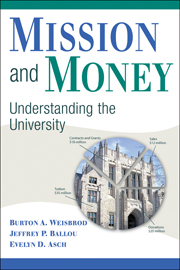Book contents
- Frontmatter
- Contents
- Illustrations
- Preface
- 1 An Introduction to the Higher Education Industry
- 2 The Higher Education Business and the Business of Higher Education – Now and Then
- 3 Is Higher Education Becoming Increasingly Competitive?
- 4 The Two-Good Framework: Revenue, Mission, and Why Colleges Do What They Do
- 5 Tuition, Price Discrimination, and Financial Aid
- 6 The Place of Donations in Funding the Higher Education Industry
- 7 Endowments and Their Management: Financing the Mission
- 8 Generating Revenue from Research and Patents
- 9 Other Ways to Generate Revenue – Wherever It May Be Found: Lobbying, the World Market, and Distance Education
- 10 Advertising, Branding, and Reputation
- 11 Are Public and Nonprofit Schools “Businesslike”? Cost-Consciousness and the Choice between Higher Cost and Lower Cost Faculty
- 12 Not Quite an Ivory Tower: Schools Compete by Collaborating
- 13 Intercollegiate Athletics: Money or Mission?
- 14 Mission or Money: What Do Colleges and Universities Want from Their Athletic Coaches and Presidents?
- 15 Concluding Remarks: What Are the Public Policy Issues?
- Appendix
- References
- Index
Appendix
Published online by Cambridge University Press: 17 July 2009
- Frontmatter
- Contents
- Illustrations
- Preface
- 1 An Introduction to the Higher Education Industry
- 2 The Higher Education Business and the Business of Higher Education – Now and Then
- 3 Is Higher Education Becoming Increasingly Competitive?
- 4 The Two-Good Framework: Revenue, Mission, and Why Colleges Do What They Do
- 5 Tuition, Price Discrimination, and Financial Aid
- 6 The Place of Donations in Funding the Higher Education Industry
- 7 Endowments and Their Management: Financing the Mission
- 8 Generating Revenue from Research and Patents
- 9 Other Ways to Generate Revenue – Wherever It May Be Found: Lobbying, the World Market, and Distance Education
- 10 Advertising, Branding, and Reputation
- 11 Are Public and Nonprofit Schools “Businesslike”? Cost-Consciousness and the Choice between Higher Cost and Lower Cost Faculty
- 12 Not Quite an Ivory Tower: Schools Compete by Collaborating
- 13 Intercollegiate Athletics: Money or Mission?
- 14 Mission or Money: What Do Colleges and Universities Want from Their Athletic Coaches and Presidents?
- 15 Concluding Remarks: What Are the Public Policy Issues?
- Appendix
- References
- Index
Summary
CHAPTER 5 APPENDIX MATERIAL
Table A5.1 breaks down university and liberal arts college tuition and grants by ranking. For universities, listed tuitions are indeed highest for top-ranked schools and lowest for those ranked outside the top 100. Average institutional aid grants per undergraduate are also highest at the top-ranked schools and decline as rankings decline. Interestingly, the top 50 schools' average listed tuitions differ little – the average for schools ranked 26–50 is only 5 percent less than for schools ranked in the top 10 – but average institutional grants per undergraduate are 33 percent lower for schools ranked between 26 and 50. At liberal arts colleges, the top 25 are comparable in terms of listed tuition and grants per student (schools ranked 11–25 actually report slightly higher grants per student), whereas lower ranked colleges set both lower list prices and provide lower grants.
Table A5.2 shows the full results for the analysis of the impact of ability and income on the degree of discounting for undergraduate students.
- Type
- Chapter
- Information
- Mission and MoneyUnderstanding the University, pp. 295 - 308Publisher: Cambridge University PressPrint publication year: 2008

